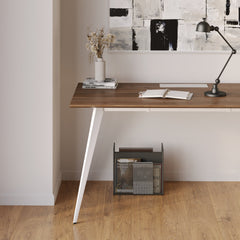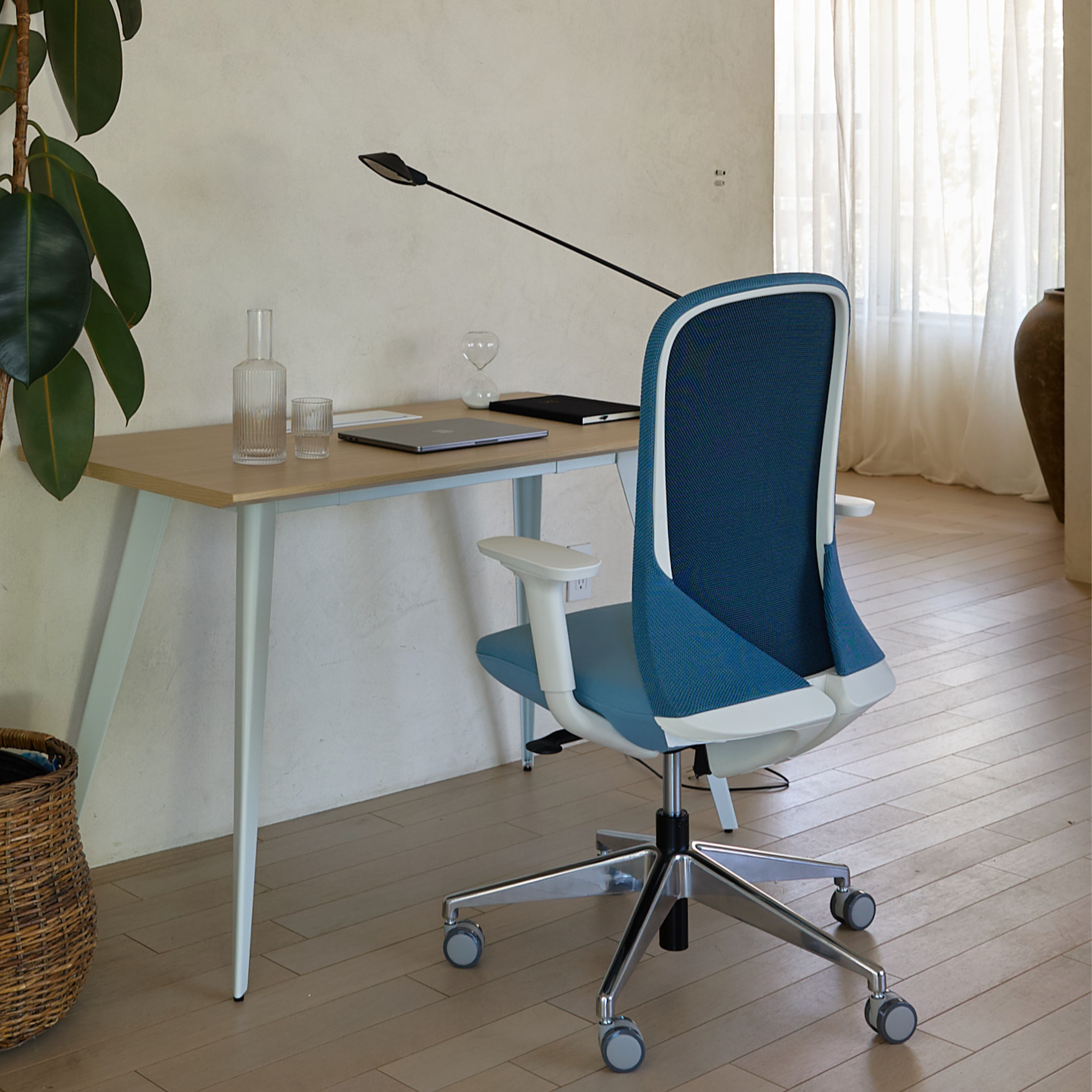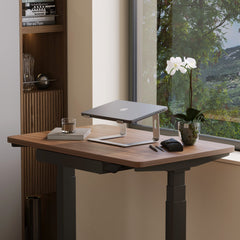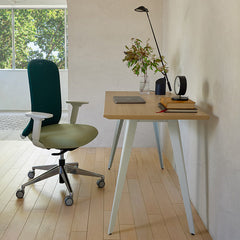Get 10% off your first order
Find the office furniture that’s designed to match your style, comfort, and needs perfectly. Subscribe
Boundary Work From Home Setup: How to Define Your Home Office Zone

Visit quiz page to see how we makes it easy to create an inspiring workplace


Working from home sounds ideal until distractions pile up and focus fades. The hum of daily life competes with your goals, leaving your energy scattered. The good news is that focus doesn’t depend on silence—it depends on design.
A thoughtful workspace can turn chaos into calm. Every piece, from your desk to your lighting, plays a part in keeping you motivated. Here’s how to shape an environment that supports discipline, comfort, and flow, even when home gets busy.
Your environment sets mental cues. A clear workspace boundary tells your brain when it’s time to focus and when it’s time to relax.
Choose a consistent spot for work, not your bed or couch.
Keep distractions like phones out of sight.
Add physical dividers such as shelves or rugs.
Use lighting changes to signal work hours.
Boundaries protect both your productivity and your peace.
Your desk isn’t just a surface—it’s your mental anchor. The Small Standing Desk New Mexico offers flexibility, helping you stay physically engaged while keeping your workspace open and focused.
|
Element |
Purpose |
Benefit |
|
Height adjustability |
Encourages movement |
Reduces stiffness |
|
Compact footprint |
Defines workspace |
Improves concentration |
|
Smooth finish |
Easy maintenance |
Calms the visual field |
|
Organized layout |
Promotes clarity |
Reduces decision fatigue |
A desk that supports posture and simplicity keeps your mind steady even when the environment shifts.
Stillness dulls focus. Movement sharpens it. A standing desk allows your body to stay active, improving blood flow and alertness.
Alternate sitting and standing every 30 to 45 minutes.
Stretch lightly during calls or reading breaks.
Keep posture upright but relaxed.
Add a small footrest to relieve pressure on legs.
Motion refreshes mental energy and prevents burnout from creeping in.
Clutter competes for attention. A tidy office desk makes it easier to concentrate and switch between tasks efficiently.
Sort essentials daily—pens, notebooks, devices.
Use drawers or trays to minimize visual clutter.
Keep one decorative piece that brings calm, not distraction.
Reset your workspace at the end of each day.
Organization isn’t perfection—it’s focus by design.
Studies on remote work highlight how environment influences motivation. According to research on work-from-home benefits, flexibility improves satisfaction when paired with structure.
|
Finding |
Meaning |
|
Dedicated spaces enhance concentration |
Separation supports focus |
|
Natural light increases energy |
Environment affects alertness |
|
Ergonomics improve comfort |
Posture influences stamina |
|
Routine builds motivation |
Predictability reduces stress |
Your home can inspire productivity when the setup aligns with your rhythm.
Decor can inspire, but too much visual noise distracts. Choose a few meaningful elements that encourage positive focus.
Keep items within your field of view simple and intentional.
Add one photo or piece of art that lifts your mood.
Use color strategically—soft blues and greens reduce tension.
Rotate items seasonally for a sense of renewal.
Simplicity allows inspiration to breathe.

Discomfort drains motivation faster than distraction. An ergonomic arm accessory supports movement and relieves tension, keeping energy consistent throughout the day.
|
Adjustment |
Effect |
|
Monitor at eye level |
Prevents neck strain |
|
Neutral wrist angle |
Reduces fatigue |
|
Feet flat on floor |
Improves stability |
|
Shoulder relaxation |
Encourages breathing |
A well-aligned posture keeps the mind sharp and the body energized.
Lighting affects not just visibility, but motivation. Dim spaces slow reaction time, while glare creates discomfort.
Use natural light for primary illumination.
Add a warm lamp to balance shadows.
Avoid overhead glare on screens.
Adjust brightness throughout the day to match energy levels.
Lighting is an unseen partner in productivity—it sets the emotional temperature of your space.
Stepping away from the desk resets attention. Short, intentional breaks keep your brain refreshed and your creativity alive.
Walk outside for a few minutes.
Practice box breathing (inhale 4, hold 4, exhale 4, hold 4).
Stretch your hands and wrists often.
Use breaks for hydration, not scrolling.
Rest isn’t a distraction—it’s recovery in disguise.
How you arrange your workspace determines how easily you stay in the zone. A balanced setup with open space promotes calm and sustained focus.
|
Feature |
Adjustment |
Benefit |
|
Desk placement |
Face a wall or window |
Reduces visual noise |
|
Storage zones |
Keep within arm’s reach |
Maintains momentum |
|
Cable management |
Hide clutter |
Improves visual flow |
|
Personal zone |
Add small plant or texture |
Boosts comfort |
When your environment feels intuitive, staying on task becomes second nature.
Discipline grows from structure, not pressure. Establishing steady rituals keeps motivation stable.
Begin and end work at consistent times.
Create morning and evening workspace rituals.
Review priorities before starting tasks.
Reflect briefly on progress at day’s end.
Routine builds momentum even when motivation fades.
A functional workspace transforms distraction into direction. When your furniture, lighting, and posture all align, you create a sense of effortless balance.
|
Element |
Purpose |
Outcome |
|
Boundaries |
Define focus |
Reduce interruption |
|
Movement |
Recharges energy |
Boosts engagement |
|
Lighting |
Shapes mood |
Supports alertness |
|
Personalization |
Inspires focus |
Sustains motivation |
Motivation isn’t a constant—it’s a practice shaped by how you work and where you work.
Color isn’t just aesthetic—it shapes mood and motivation. The right tones can calm distractions and help your mind stay centered throughout the day.
|
Color |
Effect |
Ideal Use |
|
Blue |
Boosts focus and stability |
Walls, desk accessories |
|
Green |
Calms and refreshes |
Plants, artwork, accents |
|
Beige |
Grounds energy |
Background and furniture |
|
White |
Expands visual space |
Small or bright rooms |
Balanced colors create quiet motivation, helping your mind move from chaos to clarity without effort.
What you touch affects how you feel. Smooth, natural materials bring warmth and familiarity, while harsh textures can subtly add tension.
Choose soft surfaces for arm and wrist contact points.
Mix natural textures like wood and fabric to add warmth.
Keep plastic or metallic surfaces minimal to avoid glare.
Add one tactile object—like a coaster or wood pen—to ground the senses.
A workspace that feels good under your fingertips keeps your body and mind relaxed for longer stretches of focus.
The sound environment can make or break your attention span. For some, quiet is power; for others, rhythm fuels flow.
|
Sound Type |
Benefit |
Best Use |
|
Soft instrumental |
Maintains rhythm |
Writing or planning |
|
Ambient noise |
Blocks distractions |
Open spaces |
|
Nature sounds |
Relieves tension |
Breaks or reflection |
|
Silence |
Maximizes precision |
Detailed tasks |
Experiment with what feels natural to your workflow. The goal isn’t control—it’s comfort that lets you stay immersed without strain.

Your workspace should feel like a tool for success, not a test of endurance. With thoughtful choices—like a supportive chair, balanced lighting, and quality surfaces—you build a daily environment that helps focus thrive.
Comfort fosters discipline.
Simplicity sustains focus.
Movement keeps energy fresh.
Every design choice tells your brain: “you belong here.”
A workspace created with purpose turns home distractions into opportunities for balance and growth.

Boundary Work From Home Setup: How to Define Your Home Office Zone

Hidden Hazards: 5 Ergonomic Traps Derailing Your Remote Work

Decoding Deep Work: The Neuroscience of Your Desktop
Get 10% off your first order
Find the office furniture that’s designed to match your style, comfort, and needs perfectly. Subscribe
Leave a comment